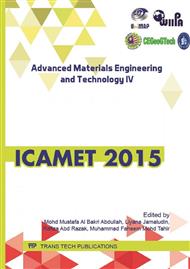p.151
p.159
p.164
p.169
p.174
p.179
p.183
p.191
p.199
The Influence of Blending Methods in Epoxy/PMMA Polymer Blend
Abstract:
Polymer blend consist of epoxy and polymethylmethacrylate (PMMA) was prepared via two different blending methods. Conventional blending method which required solvent to obtain polymer blend of PMMA and epoxy. However, due to the high consumption of solvent and environmental issue, a new approaching method: direct mixing method was used to prepare the polymer blend without the usage of solvent. The PMMA pellets are grinded and sieved into fine powders and incorporated into epoxy. Comparison between the conventional and new method was done through the investigation based on the morphology and mechanical behaviour, with different PMMA content (0, 10, 20, 30, 40 and 50 vol.%) between two blending methods. In overall, the polymer blend system prepared via direct mixing methods exhibited better mechanical properties as compared to conventional solvent dissolution method. Improvement on fracture toughness was observed in direct mixing method.
Info:
Periodical:
Pages:
174-178
Citation:
Online since:
May 2016
Authors:
Price:
Сopyright:
© 2016 Trans Tech Publications Ltd. All Rights Reserved
Share:
Citation:


